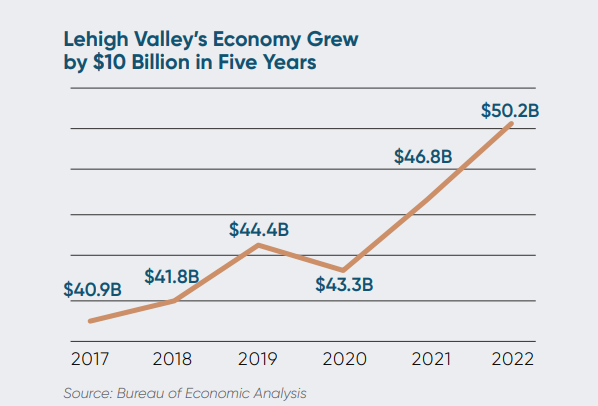When it comes to regions that achieved significant economic growth over the last year, the Lehigh Valley certainly stands out. Named the No.1 mid-sized U.S. market for economic development in 2023, the region secured a record-breaking GDP of $50 billion, simultaneously spurring an increase in the median household income and a decrease in the poverty rate.
Over the last two years, multiple international and domestic business investments have been announced in communities across the region, including B. Braun Medical ($200 million), Evonik ($700 million) and Schless Bottles ($7.5 million).
These impressive accomplishments can’t be attributed to one resource or asset alone. When I sat down with Don Cunningham, the president and CEO of the Lehigh Valley Economic Development Corporation (LVEDC), he shed light on the four main factors fueling the region’s consistent growth.
A Growing Population
“Number one, you need to be a population center of a certain size. But more importantly you need to be able to show a growing population, particularly a growing population in the 40-and-under cohort,” explains Cunningham. “Because talent is really the number one issue, both for retention and for growth and attraction.”
Since 2020, approximately 11,000 newcomers have relocated to the region, primarily in Bethlehem, Upper Macungie Township and Easton. Alongside the area’s notable quality of life, the Lehigh Valley’s abundance of employment opportunities is a major draw for younger demographics.
Over the last five years, 11,600 new jobs were created in the region, bringing the total number of jobs in the area to over 338,000. Much of this growth has been within the manufacturing sector, a significant pillar of the Lehigh Valley’s economy. More than 700 manufacturers, producing everything from medical devices and semiconductor technology to food, beverages and other consumer goods, run operations throughout the region, employing around 37,000 workers.
 The city of Bethlehem is located in eastern Pennsylvania.
The city of Bethlehem is located in eastern Pennsylvania.
Photo: Getty Images | Map & chart courtesy of the Lehigh Valley Economic Development Corporation (LVEDC)
Education Infrastructure
While population growth has helped fill the growing number of jobs in the area, the Lehigh Valley’s robust interconnected K-12, higher education and technical school system have played a major role in supplying workers and attracting job-creating projects.
“All of the school districts feed into career and technical schools,” says Cunningham. “We have a lot of engineers coming out of our schools at Lehigh University and Lafayette College. And a lot of highly trained manufacturing workers coming out of the community colleges and the technical schools. Manufacturing remains a sweet spot because of both ends of white-collar, blue-collar talent. Those collar colors have been shaded over the years, but for both the design and office side and the shop floor side there’s been a good talent pipeline.”
Access to Market
With a steady stream of manufacturers continuing to expand in the area, this sector has grown to represent 16% of Lehigh Valley’s GDP, surpassing the nation where manufacturing represents 12% of the economy. The sector’s large presence in the area has much to do with the region’s location.
“The Lehigh Valley really is an inland empire,” off the Port Newark Container Terminal 60 miles away that’s operated by the Port Authority of New York and New Jersey, says Cunningham, serving the vast East Coast metropolis with almost one-third of the United States consumers within an eight-hour truck drive. “Particularly if you’re in industrial manufacturing, you’ve got to be able to move your product in and out, and every extra mile of transportation costs money.”

Available Sites
With these benefits, it’s no wonder many companies are expanding in the Lehigh Valley region. And as demand continues to increase, Cunningham and his team are working to make room for more. Like many regional economic development agencies nationwide, creating shovel-ready sites has become a priority.
“You know, the benefits are somewhat obvious, particularly in Pennsylvania, where you’ve got most of your government, including your schools, running primarily off of property tax. The more that tax base grows, the more you can keep rates in check and be helpful to businesses,” says Cunningham. “But the challenge has become — when you’re in a growth market, when demand is high — to continue to have supply, to continue to have properties that are in good locations that are somewhat ready to go.”

The state’s new PA SITES program, initially launched as a pilot program in September 2023, strives to mitigate this problem. Communities within the Lehigh Valley and throughout the state now have the opportunity to apply for grant funding for infrastructure, utility and other improvements at proposed sites.
The Pennsylvania Department of Community and Economic Development (DCED) received over 100 applications seeking to access more than $235 million for site development, demonstrating the program’s necessity and potential. By July, PA SITES was officially established and received $400 million in the state’s 2024-25 fiscal year budget. The grants awarded through this program are intended to serve as gap financing for strategic sites to help reduce development risks for businesses.
The Lehigh Valley’s Allentown Commercial and Industrial Development Authority was among the first seven recipients awarded funding from the program’s pilot round. The organization has received over $1.1 million from PA SITES to run utility extensions for water, sewer and natural gas from existing city infrastructure to the proposed site, which is approximately half a mile.
“Population growth, education infrastructure, access to market and available buildings or land to develop. I think all that ranks higher in the end than incentives and other things that economic developers get involved in,” says Cunningham. “I always say it’s not necessarily that you’re hitting home runs, but you’re hitting a lot of singles and doubles, which add up to having a robust sector of employment and economic growth.”

